
Doctoral College Santander Mobility Awards | Isabell Nessel Awardee Report

Latest research and knowledge exchange news at Bournemouth University

The Postgraduate Research Live Exhibition is your opportunity to showcase your research this academic year with the Doctoral College.
Calling all PGRs! Exhibit your research or research journey at this PGR Live Exhibition on Wednesday 5 December, followed by a free festive social for PGRs and Supervisors.
This is your opportunity to display your research to all of BU in creative and innovative ways during this open live exhibition.
Follow this link for full details on how to submit, joint submissions are accepted.
Please contact Natalie Stewart if you have any questions.
Please contact your student representatives about faculty run PGR conferences which may be scheduled for this academic year.

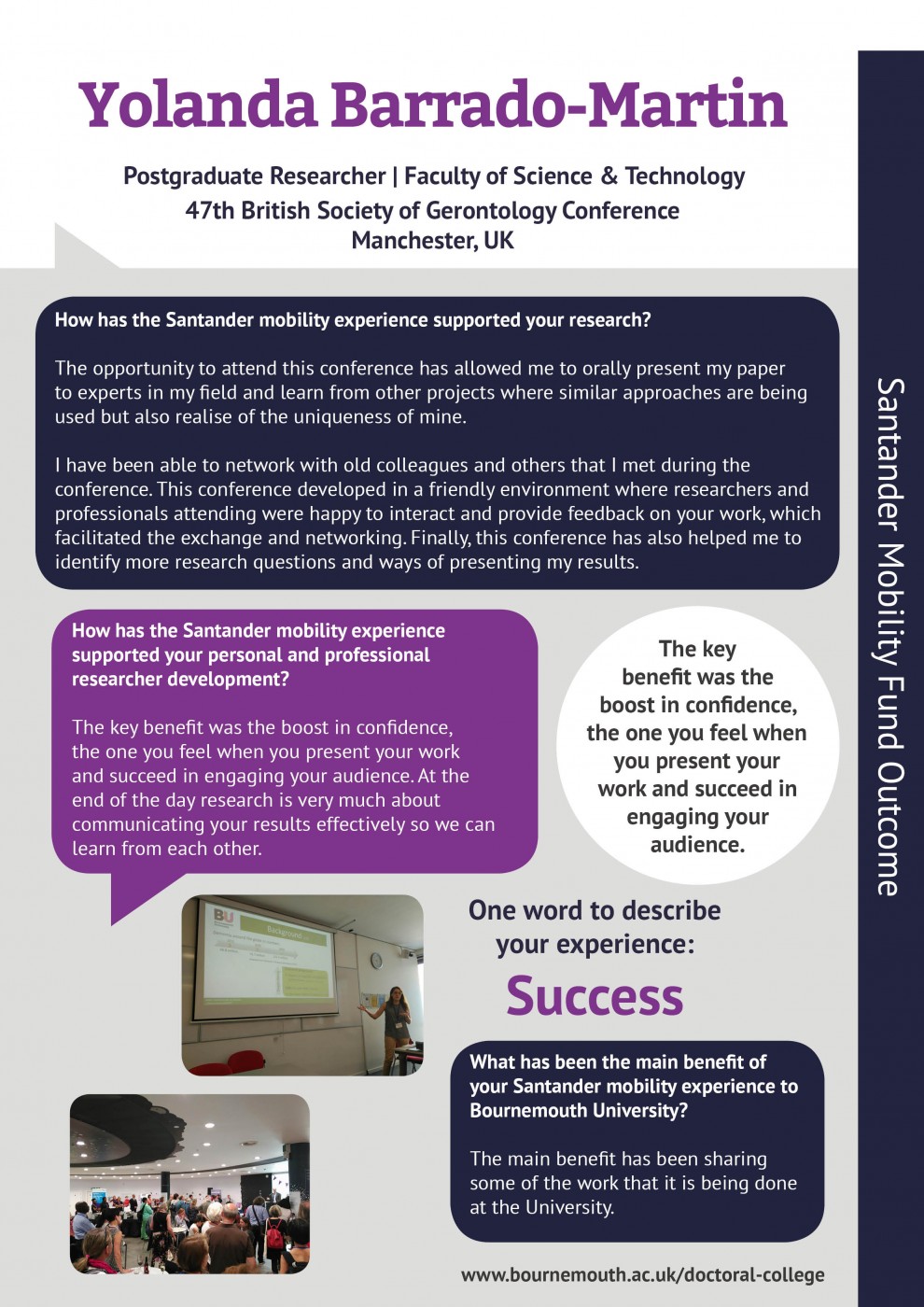
Congratulations to Lesley Milne, senior lecturer in midwifery, on the acceptance of her latest paper on maternity care in Nepal. This new paper ‘Gender inequali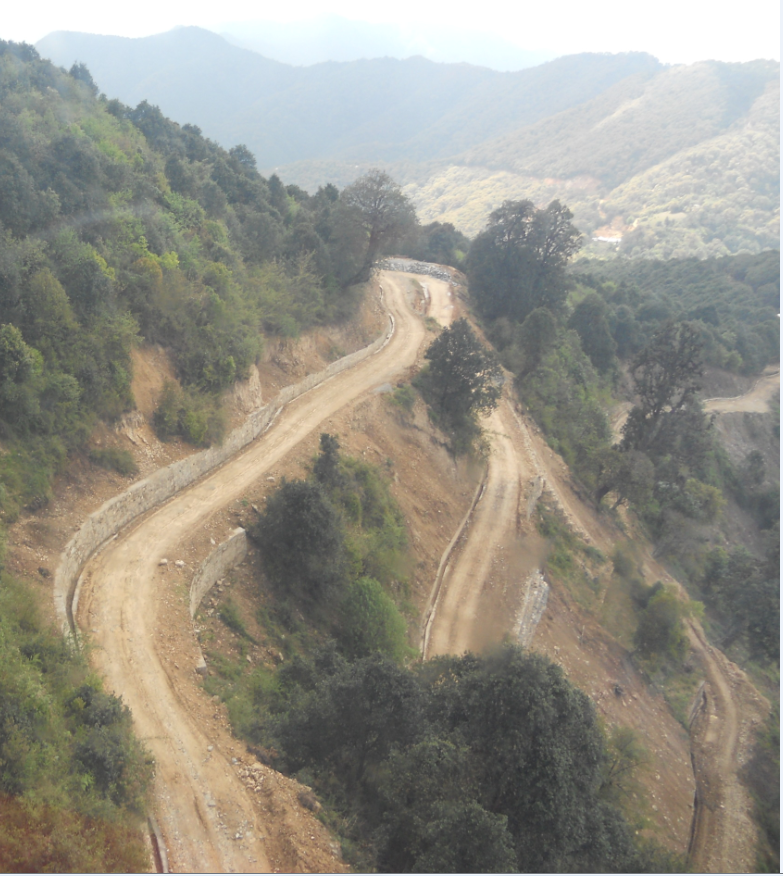 ties and childbearing: A qualitative study of two maternity units in Nepal’ will appear soon in the Open Access publication: Journal of Asian Midwives [1]. This is the second publication from a qualitative research study undertaken in two birthing facilities in Kathmandu Valley to examine barriers to women accessing these services from the perspective of hospital staff [2].
ties and childbearing: A qualitative study of two maternity units in Nepal’ will appear soon in the Open Access publication: Journal of Asian Midwives [1]. This is the second publication from a qualitative research study undertaken in two birthing facilities in Kathmandu Valley to examine barriers to women accessing these services from the perspective of hospital staff [2].
The study received financial support from Wellbeing of Women and the RCM (Royal College of Midwives) as Lesley won their first International Fellowship Award. The study was a collaboration led by Lesley in the Centre for Midwifery, Maternal & Perinatal Health (CMMPH) with two of FHSS’s Visiting Faculty, namely Prof. Padam Simkhada who is based at Liverpool John Moores University and Jillian Ireland, Professional Midwifery Advocate based at Poole NHS Hospitals Foundation Trust.

Well done!
Profs. Vanora Hundley & Edwin van Teijlingen
References

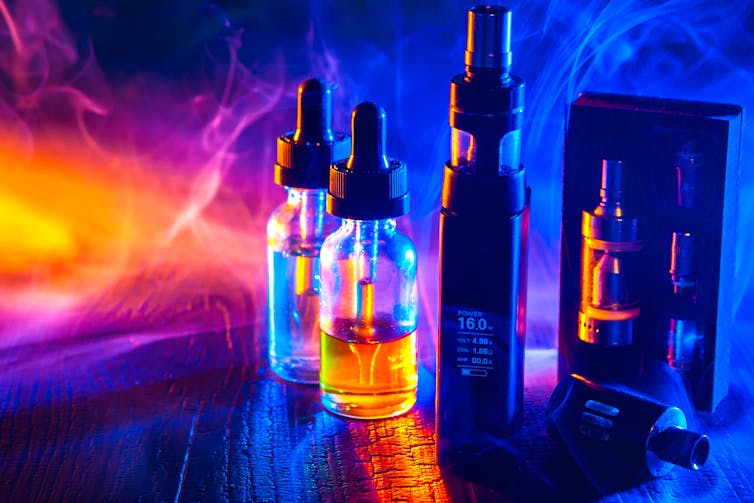
Sulaf Assi, Bournemouth University
Over 35m people worldwide now use e-cigarettes, according to one estimate. In the US, this includes 4.5% of the adult population. But the rise in vaping has led to a trade in fake e-liquids – the mix of water, glycerol, propylene glycol, flavours and (usually) nicotine used to create the vapour of e-cigarettes.
Fake e-liquids are those that contain ingredients or incorrect concentrations of them that do not match those on the label. In particular, fakes often contain less or more nicotine than their labels claim, or impurities such as other drugs. The problem is that there is no current way to be sure exactly what is in an e-liquid, and no official certification scheme to guarantee that a label claim is accurate.
However, my colleagues and I are working on a way to use handheld scanning technology to spot fake e-liquids. This system could help to catch fraudsters because it does not just prove an e-liquid does not match its labelling but also provides a chemical “fingerprint” that can be linked back to its creators.
The internet has made it much easier for fraudsters to sell fake goods, and e-liquids are no exception. The problem is still new enough that we do not have good data on how common it is, but anecdotal evidence suggests many vapers are aware of the issue.
Nicotine e-liquids typically contain concentrations of between 0.1% and 2% of the drug, depending on the strength the vaper prefers. Current EU law means higher concentrations of nicotine than this are illegal. And manufacturers are required to declare any ingredient that accounts for more than 0.1% of its content.
Buying a fake e-liquid is not just annoying, it is potentially dangerous. It is rare for someone to consume so much nicotine that it becomes toxic, but it can happen. High doses of nicotine can result in unwanted stimulant effects such as hypertension (high blood pressure), tachycardia (unusually high heart rate), tremors and even seizures. Impurities in nicotine can also affect the body but this is difficult to predict and depends on what the impurity is and its concentration.
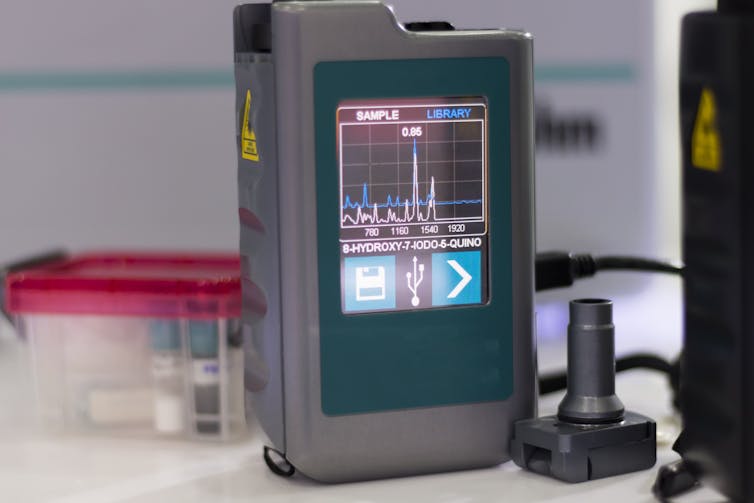
Having a portable technology that can authenticate products would help law enforcement officers identify fake e-liquids, catch the criminals supplying them and so prevent the health problems they cause. So we have tailored portable scanning technology already used to detect other counterfeit products including medicine and food, by creating a library of chemical signatures for e-liquids and the software to compare them to the scan results.
The technology works by firing near-infrared light at a sample. Different ingredients will reflect or absorb the light by different amounts. So measuring this reflection gives a spectrum that acts like a fingerprint, which we can use to identify the liquid’s physical and chemical properties. Our algorithms can then interpret this fingerprint and compare it to our library of other spectra to assess how likely it is that the liquid contains what the label says it does.
Using this kind of portable spectroscopic technology saves on the cost, labour and time of taking a sample into the laboratory, preparing and measuring it and then processing the data. Instead, our system can scan a sample and tell users how close a match it is to entries from the library – and so how much nicotine and other ingredients it contains – without the need for them to have specialist training. Collecting a signature takes a few seconds and the results are ready within a couple of minutes. The equipment is also stable in hot and cold climates and can be used in the field for long periods of time.
As portable versions of these instruments are already available for detecting fake drugs and tobacco, it would be easy to adapt them for law enforcement agents. All you need to do is develop the right library of chemical signatures to detect a variety of fake e-liquids, as we have started doing. Then the police can start cracking down on this potentially dangerous trade.![]()
Sulaf Assi, Senior lecturer in forensic sciences, Bournemouth University
This article is republished from The Conversation under a Creative Commons license. Read the original article.

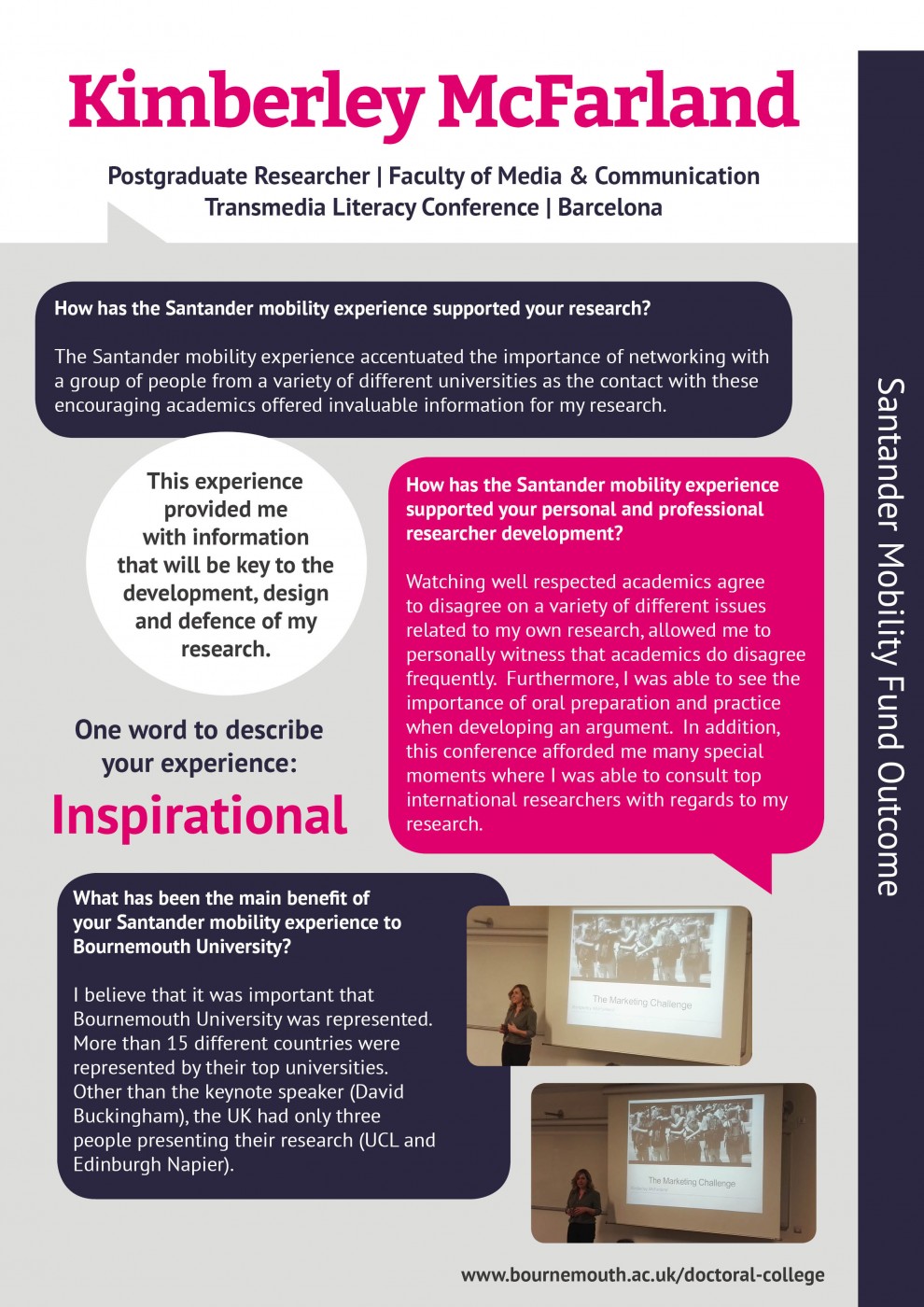
Congratulations to Amy Miller! At the British Chiropractic Council’s annual conference 13-14th October, Bournemouth University PhD student Amy Miller was awarded the British Chiropractic Association’s award of ‘Chiropractor of the Year 2018-19’ for her contributions to research and engagement. 
Amy is based in the Faculty of Health & Social Sciences (FHSS). Her PhD is investigating an inter-professional student-led breastfeeding clinic for student learning, and breastfeeding outcomes and experiences. Amy is supervised by Associate Professor Sue Way, Senior Lecturer in Midwifery Dr. Alison Taylor and Prof. Edwin van Teijlingen all based in the Centre for Midwifery, Maternal & Perinatal Health (CMMPH). The British Chiropractic Association’s award for Chiropractor of the Year recognises individuals who have made a significant contribution to the profession.
The Postgraduate Research Live Exhibition is your opportunity to showcase your research this academic year.
Calling all PGRs (MRes, PhD, Professional Doctorates alike)! Exhibit your research or research journey at this PGR Live Exhibition on Wednesday 5 December, followed by a free festive social for PGRs and Supervisors.
This is your opportunity to display your research to all of BU in creative and innovative ways during this open live exhibition.
Only 1 week left to apply.
Follow this link for full details on how to submit, joint submissions are accepted.
Please contact Natalie Stewart if you have any questions.
Please contact your student representatives about faculty run PGR conferences which may be scheduled for this academic year.





Shelley Thompson, Bournemouth University
Until this year, only 19 women had won a Nobel Prize for science – just 3% of the total winners. But the Nobel Committee’s decision to recognise Donna Strickland and Frances Arnold, respectively, with the 2018 chemistry and physics prizes, suggests this imbalance is finally being addressed.
The Nobel recognises outstanding contributions to humankind, so it should go without saying that the outstanding women working in the fields of science and medicine should be recognised for their contributions. And there are many who deserve to be seen through awards and media representations. But perhaps more importantly, the image we see of women in science from things like the Nobel Prizes can make a difference to what happens within the field.
Women laureates are grossly underrepresented in all of the Nobel Prize categories, especially when you consider their participation in these areas today. Globally, women still represent less than a third of the science workforce, but that’s far more than the 3% recognised by the Nobels.
Even in the last few years, as more women have entered scientific fields, they have been notably absent among Nobel prize winners. The last woman to win the chemistry prize was Ada Yonath in 2009. And before Donna Strickland there hadn’t been a female physics laureate since Maria Goeppert Mayer in 1963. The Nobel Committee has said it is taking steps to improve its record on women but that it would likely be five to ten years before we see a significant change in distribution.
The reality is that women are still under- and misrepresented in almost every facet of science. The numbers start with a lower proportion of female science students at secondary level and gradually decline at every stage of education and leadership. For example, women are underrepresented as first authors of scientific research papers and their papers are much less likely to be cited by others. By the time it gets to candidates for the Nobel Prize, there are very few women left to choose from.
You can add to that the persistence of outdated ideas around gender differences within science. Just recently, a CERN professor was suspended for sexist comments linked to debunked science made to a room full of women scientists. In many ways, it made Strickland’s winning of the physics Nobel all the more sweet but demonstrates the lingering mischaracterisation of women in science both inside and outside of the profession.
With all this mind, it’s important to remember that media representation matters. It gives women and girls opportunities to literally see themselves, in this case, as scientists. We know from research that female role models can make a difference to women’s decisions about whether or not to start a scientific career. And more generally, media representations help us to understand ourselves and others. So, if images of successful women are missing from the picture girls and women have of science through the media, it can limit the extent to which they will see themselves as scientists.
We need to normalise the representation of all women in science. More women winning the Nobel Prize, and more news articles celebrating those women’s achievements, are just the start. Changing how women scientists are seen can also be achieved through film and television representations, news articles, Wikipedia entries and so on.
Globally, for example, women made up only 19% of experts appearing in television, radio and print news reports. When women scientists are made less visible in this way, they are, in the words of feminist thinker Gaye Tuchman, “symbolically annihilated”. In other words, they are effectively omitted, trivialised and condemned by the mass media.

While there are many examples of women scientists in film and television, they’re now starting to appear more often as lead characters rather than as sidekicks to men – for example, Sandra Bullock’s Ryan Stone in Gravity. Recent films such as Hidden Figures and the reboot of Ghostbusters have made the female leads’ role as scientists a key focus and driver of the storylines. This kind of change is important for moving women scientists from, as feminist critic bell hooks puts it, the “margins to the centre”.
Even the number and content of Wikipedia entries about women scientists is important, as the crowd-edited encyclopedia helps document what society values and exposes people to cultural heritage. But research shows that Wikipedia has a poor record on gender equality in terms of including women’s biographies.
This was highlighted when it emerged that, before her Nobel win, Strickland’s contributions to science had been deemed not significant enough to warrant her own Wikipedia page. Such examples underline the importance of efforts like those of Jessica Wade to increase the number of Wikipedia entries about women scientists’ contributions.
Changing all these media representations together can help more people to see women as scientists and to value the contributions that they make. This will empower women scientists today and inspire more girls to join the next generation. Perhaps then, a Nobel Prize winner being female won’t be such big news and the focus will be on their science rather than their gender.![]()
Shelley Thompson, Head of School of Journalism, English & Communication, Bournemouth University
This article is republished from The Conversation under a Creative Commons license. Read the original article.

Dr Terri Cole’s co-written book Forensic Psychology: Theory, Research, Policy and Practice (2015), with Jennifer Brown (London School of Economics) and Yvonne Shell, has won the British Psychological Society Book Award 2018 in the Textbook category. The Society’s Book Award recognises excellent published work in psychology and recipients will be presented with a commemorative certificate at the Society’s Annual Conference.

Forensic Psychology: Theory, Research, Policy and Practice (2015) is primarily targeted towards Masters students studying Forensic Psychology, as well as practitioners and those already qualified who need to keep up with the CPD (Continuing Professional Development). It is also a useful companion to professionals in allied criminal justice professions.
Students of Forensic Psychology need to learn how to combine practical skills such as report writing or assessments with a critical understanding of both theory and the wider political and policy landscape that surrounds the profession, and Dr Cole’s book will help them to understand how these crucial areas of the profession interact and how they can shape one another.
The text provides a detailed analysis of key concepts, debates and theories while weaving in insights and reflections from key professionals working in practice from all fields amidst the text, ensuring readers have the necessary knowledge and skills to pass assignments and get past the stage 2 supervised practice requirements en-route to becoming a qualified forensic psychologist.
“Rather than just summarising the theory, we have incorporated ours and others’ practical experiences and lessons learnt adding a human element and discussing wider points from the political framework in which our work is based, to the personal toll of working in such a domain,” says Dr Cole.
Sarb Bajwa, chief executive of the British Psychological Society, says: “I congratulate all the award winners whose varied expertise emphasise the depth and diversity of psychology. The fact that we were able to recognise three such distinguished and appealing books shows that psychology publishing is in good health. What shines through in each of these books is a relentless focus on good science and an insistence on following the evidence.”
For more information on this book, contact Dr Terri Cole here.

Congratulations to FHSS academics Dr. Pramod Regmi and Dr. Nirmal Ayral who published an editorial yesterday in a scientific journal in Nepal. The paper ‘Experts warn Nepal Government not to reduce local Public Health spending’ [1] was co-authored by Dr. Bibha Simkhada who has just been offered a post as Lecturer in Nursing in the Department of Nursing & Clinical Sciences, she shall be starting with us on November 1st. Further co-authors include FHSS Visiting Professor Padam Simkhada and Dr . Sujan Marahatta, the journal’s editor. He is based at Manmohan Memorial Institute of Health Sciences (MMIHS) in Kathmandu, Nepal. Bournemouth University has a long-standing research collaboration with MMIHS.
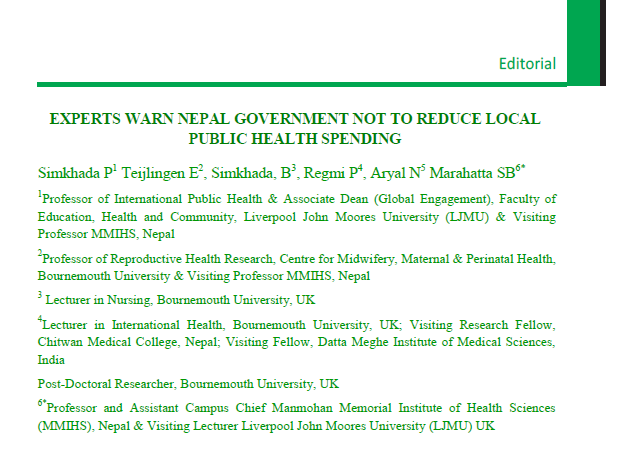 The editorial warns about the risks of losing the focus on public health and its wider national and global perspective in the recently changed political arena of Nepal. Since 2015 Nepal has moved from a central state to a federal republic, whereby the seven new Provinces have gained much more power and control in the decentralisation process. Moreover the first local elections for two decades in 2017 meant a lot of new and inexperienced local politicians were voted in. Many of these local people had little prior experience of political processes, governing health systems, the notion of priority setting, running sub-committees of elected representatives, political decision-making at local level, etc. The paper argues that Public Health can easily disappear of the radar. The untrained newly elected representatives with no political experience are most likely to be drawn into proposing and supporting popular measures including developing new buildings, black-top roads, hospitals, etc., rather than measures that increase the local or regional budget for teachers, Continuous Professional Development (CPD) for community health workers, and preventative public health measures in general. Buildings and roads are immediate demonstration to voters that politicians have done something useful, reducing maternal mortality by 2.6% or employing two additional health workers doesn’t give politicians neither the same publicity, nor do such policies have immediate signs of success, and hence are unlikely to be vote winners.
The editorial warns about the risks of losing the focus on public health and its wider national and global perspective in the recently changed political arena of Nepal. Since 2015 Nepal has moved from a central state to a federal republic, whereby the seven new Provinces have gained much more power and control in the decentralisation process. Moreover the first local elections for two decades in 2017 meant a lot of new and inexperienced local politicians were voted in. Many of these local people had little prior experience of political processes, governing health systems, the notion of priority setting, running sub-committees of elected representatives, political decision-making at local level, etc. The paper argues that Public Health can easily disappear of the radar. The untrained newly elected representatives with no political experience are most likely to be drawn into proposing and supporting popular measures including developing new buildings, black-top roads, hospitals, etc., rather than measures that increase the local or regional budget for teachers, Continuous Professional Development (CPD) for community health workers, and preventative public health measures in general. Buildings and roads are immediate demonstration to voters that politicians have done something useful, reducing maternal mortality by 2.6% or employing two additional health workers doesn’t give politicians neither the same publicity, nor do such policies have immediate signs of success, and hence are unlikely to be vote winners.
The Journal of Manmohan Memorial Institute of Health Sciences is part of the Open Access publishing of Nepal Journals OnLine (NepJOL) supported by INASP. The editorial also illustrates the kind of work conducted in Bournemouth University’s Integrative Wellbeing Research Centre (iWell).
Prof. Edwin van Teijlingen
Centre for Midwifery, Maternal & Perinatal Health (CMMPH)
Reference:
Simkhada, P., Teijlingen van, E., Simkhada, B., Regmi, P., Aryal, N., Marahatta, S.B. (2018) Experts warn Nepal Government not to reduce local Public Health spending, Journal of Manmohan Memorial Institute of Health Sciences, 4(1): 1-3.